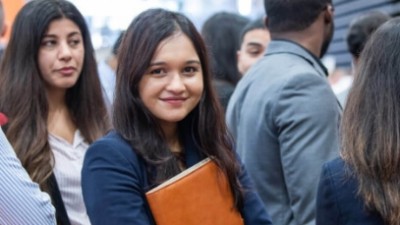Business students earn Google AdWord grant
Search engine marketing raises awareness for CURE Childhood Cancer Association
Three students from RIT’s E. Philip Saunders College of Business won a $10,000 grant from the Google for Nonprofits program to help develop an online advertising campaign for the CURE Childhood Cancer Association.
Google AdWords target the right customers to businesses and resources through pay-per-click online advertising, but in this case, developing “keywords” for the search engine site became more than a class project requirement for three students from Rochester Institute of Technology’s E. Philip Saunders College of Business.
Andrew Fleckenstein, Kyle Ackerman and Courtney Tennant—all students in the new media marketing program at RIT—applied for, and won, a $10,000 grant from the Google for Nonprofits program. In turn, they spent a semester developing Google AdWords to help raise awareness for a nonprofit client in the area, the CURE Childhood Cancer Association. Located at 200 Westfall Road, CURE was formed in 1976 by a group of Rochester parents who lost their children to cancer.
“Ten thousand dollars is a lot of money to play with, and Google sifts through thousands of applications, so the three-month grant is a big deal for a nonprofit organization that wants to increase its visibility,” says Raj Murthy, assistant professor of marketing in the Saunders College.
In the spring of 2011, Murthy pioneered the Search Engine Marketing and Analytics class as part of RIT’s paradigm-shifting new media marketing curriculum. He encouraged the students to apply for the Google for Nonprofits grant, they heard they won and “it was a go” three weeks later.
As the students explain, when online users search for a product or service in the Google Search Engine, out pop several keyword-driven ads that show up on the right-hand of a Google search page under the headline “sponsored links” that target and direct users to a particular website. The more relevant the ad, the higher it appears on the list, and with one click, advertisers can receive variable dollar amounts for each visit.
For Ackerman, selecting to help CURE—which offers emotional, educational and financial assistance for families coping with childhood cancers or blood disorders—was a personal connection.
“My mom was diagnosed with breast cancer when I was in high school and we lived in Binghamton and she ended up going to New York City for treatment,” Ackerman explains. “You will do anything it takes, fly across the country to get the help you need. So our Google AdWord grant will help those people who need resources from CURE.”
Brian Wirth, executive director at CURE Childhood Cancer Association, says he was thrilled to learn the students had decided to help establish a Google Ad Words grant.
“To a small organization like ours, with limited resources, the support of young students like these means so much to our future success,” says Wirth. “This grant will allow us to spread our message about our organization and raise funds in support of our mission.”
The students have been fine-tuning keywords that would redirect online traffic to CURE by targeting a 60-mile radius. “We are constantly adding new keywords and fixing those that don’t work,” says Fleckenstein. “You have to put yourself in the customer’s seat. If your kid had cancer, what would you type in?”
Tennant, who is graduating this May and intends to pursue her MBA degree at RIT, says they received the most hits with keywords such as “cancer cure,” “donate to kids,” “childhood cancer” and “what is cancer.”
According to Murthy, major search engines like Google (AdWords), Bing and Yahoo (adCenter) help business owners and organizations that often struggle to afford advertising for their products or services.
“There’s not another school in upstate New York that teaches this, and the emphasis here at the Saunders College of Business is to help local nonprofit companies benefit from online advertising while helping their customers make decisions on the best services available,” he says. “In that sense, AdWords is the ideal tool—the ability to track the results online is phenomenal and eventually we’ll know what type of return we see from each dollar we spend.
“This is not an easy class,” Murthy emphasizes. “Students in the program will be able to walk out after graduation and get a job.”














